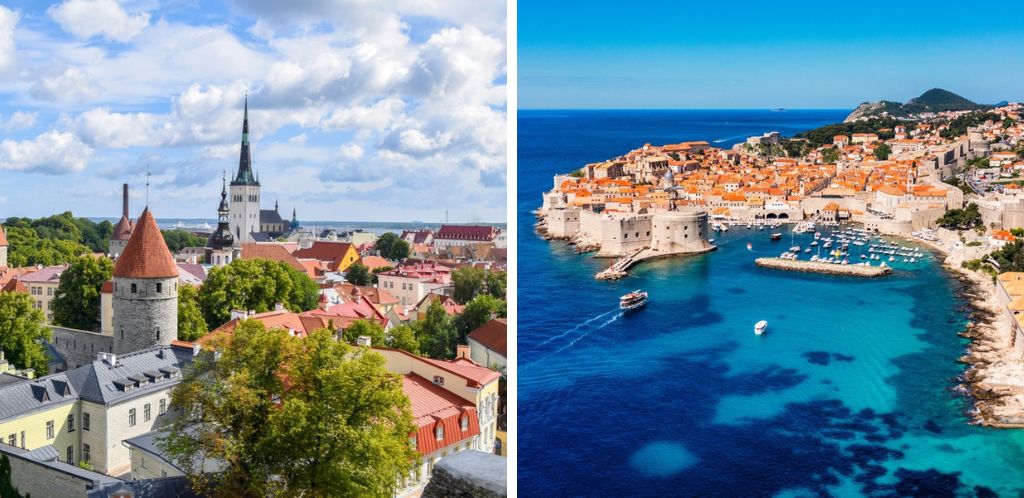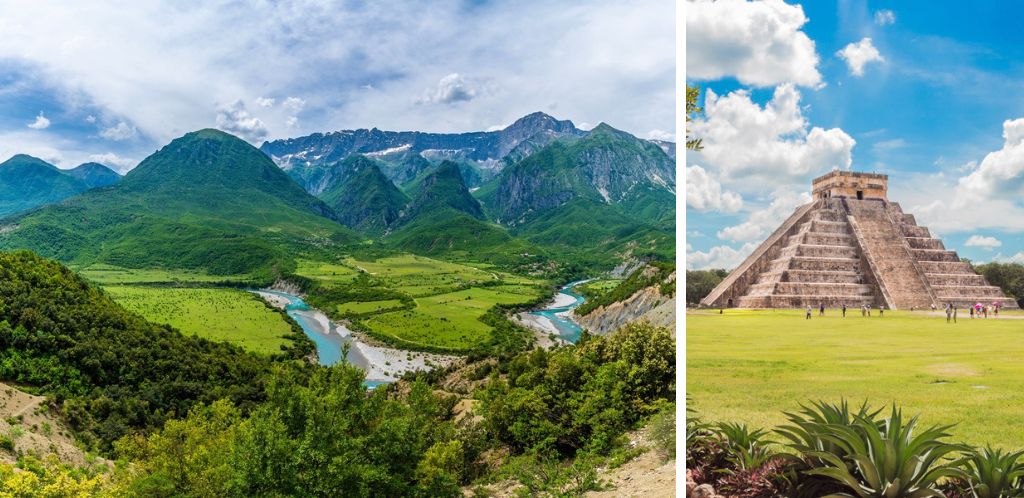Cheapest Digital Nomad Visas: Learn How to Apply
Do you dream of working remotely while travelling, but you’re on a tight budget? These are the cheapest visas for digital nomads.
The idea of living and working from any corner of the globe is more possible than ever thanks to digital nomad visas. But for many, adding an administrative fee to the ticket and initial travel costs is a barrier. Is this your case? Well, you’ve come to the right place, because today we’re going to tell you which are the cheapest visas for digital nomads.
Among the list of 65 countries that have one of these special visas for remote workers, there are some options that are affordable for all. Legal residence permits in the country of your choice that fit even the tightest of budgets and with which you can spend time in your dream places. Are you curious to know which are they? Join us to discover the five cheapest digital nomad visas in the world.
What’s a digital nomad visa?
Let’s start at the beginning, what are these visas? Times are changing, that’s not news at this point. With these changes, new ways of life and new needs have emerged. In order not to be left behind, countries have had to find ways to adapt, attract talent and energise their economies. One of the most innovative responses has been the creation of visas for digital nomads: Residence permits designed for those who work remotely while exploring the world.
Unlike traditional visas, these are designed to accommodate the flexible lifestyle of digital nomads. The requirements are usually simple: Stable income, remote employment or proof that you work for international clients. In addition, they often offer different advantages, such as extended stays and, in some cases, tax benefits. Even with the possibility to travel with dependents!
What costs to consider when getting a digital nomad visa?
As you can see, they look good. They allow you to spend a period of time legally in the country of your choice. But, unfortunately, they are not free. In addition to collecting documents and filling out forms, you’ll have to pay the corresponding administrative fees to get one. Other costs, such as translations or health insurance, must also be borne.
Although the associated costs may vary depending on the country you choose, there are some costs common in most application proceedings. Let’s break them down so you know exactly what you’ll have to pay:
1. Financial solvency
Although it’s not a payment as such, it must be mentioned. One of the most common requirements for obtaining a digital nomad visa is to prove that you have sufficient income for a living during your stay. To prove this, you’ll need to provide bank statements, pay slips or contracts that demonstrate your financial stability.
Some countries require opening a local bank account or even blocking a minimum amount of money as collateral. For example, in European destinations such as Estonia, you must prove a monthly income equivalent to twice the local minimum wage.
2. Application fee
The application fee is a compulsory charge in all countries (there used to be some free of charge, such as Georgia’s digital nomad visa and Estonia’s). This amount covers the analysis and processing of your case by the immigration authorities. Depending on the country, it can range from €30 to €500 ($55 to $530). It’s paid at the time you submit your application and is usually non-refundable in case you are refused.
3. Health insurance
Many countries require international health insurance as part of their visa requirements. It should cover emergencies and, in some cases, repatriation. Depending on the coverage and the length of your stay, prices can vary from €20 to €150 ($22 to $160) per month.

4. Translation of documentation
If your documents aren’t in the official language of the country you want to move to, you’ll need to translate them. Bank certificates, employment contracts and even your passport may need a certified translation. This service usually costs between €20 and €50 ($22 and $55) per page, depending on the language and complexity of the document.
5. Residence card issuance: An additional expense you shouldn’t forget about
Once your visa has been approved, some countries require an additional step: Obtaining a residence card or permit to stay. This physical document not only confirms your legal status, it’s also mandatory for procedures such as opening a bank account or registering for local services.
Bear in mind that the procedure to obtain this card can increase the costs considerably. The price can vary greatly depending on the country and the type of visa. In countries such as Spain and Portugal, the issuing fee is around €15 (around $16). In other, stricter countries, such as the United Arab Emirates, the costs associated with a residence card can exceed $100.
6. Other additional costs
In general, these are the costs you’ll have to bear when applying for any digital nomad visa. Depending on your circumstances, you may have to take on others such as:
- Medical tests: Some countries require a medical check-up before approving your application. The cost varies, but can range from €50 to €200 ($55 to $215).
- Travel for formalities: If you need to submit your application in person at an embassy or consulate, you’ll need to include transport and accommodation costs in your budget.
- Priority services: In some cases, you can pay extra to speed up the process. This can cost between €50 and €200 ($55 and $215), depending on the country.
The 5 cheapest visas for digital nomads
Thus exposed it may seem that there are too many expenses to get a digital nomad visa. Don’t give up on the idea of going off to travel the world with your job on your back just yet, wait. First, take a look at these five visas we’ve found. Their administrative fees are affordable and the financial requirements are also quite reasonable.
1. Estonia’s digital nomad visa: Affordable and with great benefits
If you are looking to work remotely from a country with a world-class technology ecosystem and a reasonable cost of living, Estonia’s digital nomad visa is an excellent option. With an application fee of €80 (around $85), it’s positioned as one of the most affordable alternatives in Europe. It also allows you to enjoy the advantages of residing in a member country of the European Union.
Why is it one of the cheapest?
- Reasonable application fee: Compared to other European visas that can exceed €100, the Estonian visa is quite cheap. It costs €80 for a type C visa (short stay) and €100 for a type D visa (long stay).
- Reasonable income requirements: A minimum monthly income of €3,504 (about $3,700) is required. Although it isn’t low, it’s compensated by the reasonable cost of living in Estonia. Accommodation, transport and services are competitively priced.
- No need to pay for a residence card: In Estonia, the digital nomad visa allows you to work and reside for up to 12 months without having to apply for a residence card.
Advantages that make this visa stand out
- Access to the Schengen area: Although it doesn’t grant permanent residence, it allows you to move within the Schengen countries for a certain period of time.
- Advanced digital ecosystem: Estonia is known as one of the most innovative countries in the world. Here, everything from signing documents to accessing public services can be done online.
- Affordable quality of life: In cities like Tallinn, the balance between cost and quality of services makes life comfortable and accessible.
- Growing international community: Estonia is in vogue among the nomad community, you’ll easily find like-minded people.

2. Croatia Digital Nomad Visa: Affordable and with a view of the Adriatic Sea
Croatia has become a magnet for digital nomads seeking an accessible destination with Mediterranean scenery and a relaxed lifestyle. Your digital nomad visa costs about €60 (around $65). And, as well as being economical, it allows you to live and work in a place full of history and culture without going broke.
What makes this visa an economical option?
- Affordable application fee: Amounting to €80-€130, Croatia’s digital nomad visa is significantly cheaper than those in countries such as Dubai, which costs over $600. Or Australia’s, which is around $300.
- Reasonable income requirements: You’ll need to prove a minimum income of €2,232 per month (about $2,320). A moderate amount compared to the $5,000 demanded by the United Arab Emirates or Estonia’s $3,700.
- Residence card fee: Once the visa is approved, the cost of issuing the residence card is 240 kuna (around $32).
Advantages that make this visa stand out
- Affordable accommodation: Renting a one-bedroom flat in Zagreb or Split costs about €500 (around $540). Much cheaper than in cities such as Lisbon, where rents are over €800.
- Mediterranean scenery and quality of life: After work, you can relax on the Dalmatian coast or explore the country’s historic cities. Croatia combines tranquillity and productivity like few other places.
- Growing international community: Cities such as Dubrovnik have seen a boom in digital nomads. You’ll find active networks where it’s easy to connect and collaborate.
- Easy access to the rest of Europe: Although not part of the Schengen area, Croatia has fast and cheap connections to neighbouring countries.
Important: If you are a frequent traveler and want to stay connected without worrying about expensive roaming or looking for a new SIM at every destination, Holafly’s subscription plans are for you. With a single eSIM, enjoy internet in more than 170 countries for a fixed price and no surprises on your bill. Travel without limits and connect easily and securely! 🚀🌍

3. Mexico’s digital nomad visa: An affordable option in Latin America
With an application fee of just M$940 ($53), this visa is one of the cheapest in the world. Add to that an affordable cost of living and the possibility of working remotely from some of Latin America’s most fascinating destinations.
Why this visa is one of the cheapest?
- Very low application fee: For just $56, Mexico’s digital nomad visa is cheaper than visas such as the Czech Republic’s, which costs €200 (around $210). Or Barbado’s, which is around $2,000. This makes it an ideal choice for those looking to minimise their initial outlay.
- Resident card fee: To obtain a temporary resident card, a fee of M$4,739 ($260) is payable.
- Reasonable financial requirements: You need to demonstrate a monthly income of $1,620 (or a bank balance of at least $27,000). Although it’s higher than in Portugal, it’s still competitive compared to destinations such as Dubai, which requires more than $5,000.
Advantages of working from Mexico
- Affordable cost of living: Living in cities like Mérida or Guadalajara can cost less than $1,000 per month, including rent, food and transport. Even in Mexico City, one of the largest cities in the world, costs remain reasonable.
- Cultural and natural diversity: Mexico offers paradisiacal beaches, colonial cities, jungles and mountains. Working in a place with so much variety is a privilege.
- Proximity to the United States and Canada: If you need to stay connected to North America, Mexico offers frequent, cheap flights and a convenient time zone.
4. Portugal’s digital nomad visa: Affordable and with the European charm
Portugal combines history, modernity and a pleasant climate. It’s a popular destination for remote workers who live on the move. Portugal’s digital nomad visa has an initial cost of between €75 and €90 (around $78-$94).
What makes this visa stand out?
- Moderate application fee: Compared to more expensive visas such as that of the United Arab Emirates (over $600), Portugal’s is an economical option.
- Minimum financial requirements: With only €705 (around $750) of monthly income, Portugal requires less than most European destinations.
- Residence card fee: The cost of issuing the residence card is €158 (around $165).
Benefits of choosing Portugal
- Competitive cost of living: Renting a flat in cities such as Porto or Lisbon can cost between €700 and €1,000, a reasonable figure for Western Europe.
- International connection: From Portugal, you can travel anywhere in Europe without any problems. It also has direct flights to America and Africa.
- Exceptional culture and gastronomy: Enjoying the sun, wine and Portuguese food while you work is an experience that is hard to beat.

5. Albania’s digital nomad visa: Affordable and in growth
Albania is a destination that’s gaining popularity among digital nomads thanks to its low cost of living and recent openness to digital tourism. With an application fee of approximately €50 (around $55), this visa is perfect for those looking for an affordable and less crowded place to stay.
Why this visa is a cheap option?
- Low application fee: For only 50 euros, it’s lower than most visas available in Europe. The exact amount depends on the nationality of the applicant.
- Flexible financial requirements: Although there’s no fixed minimum, you need to demonstrate sufficient financial solvency for your stay. This makes it accessible to a wide range of budgets.
- No need to pay for a residence card: In Estonia, the digital nomad visa allows you to work and reside for up to 12 months without having to apply for a residence card.
What advantages does Albania offer?
- Very low cost of living: The digital nomad visa in Albania will allow you to live in cities like Tirana, where rents can cost less than €700 per month (and that includes rent and basic expenses).
- Spectacular landscapes: Albania offers mountains, crystal-clear beaches and historic cities that you can explore off your working hours.
- Developing infrastructure: Although it doesn’t have the connectivity of other European countries, it’s improving rapidly and is ideal for those seeking a quiet destination. In addition, you can always make use of the Holafly Connect plans.
Which is the cheapest visa for digital nomads?
Before analysing the cheapest visa for digital nomads, we could say that Mexico’s is the cheapest. However, when all the costs are laid out, it’s clear that the Albanian digital nomad visa is the cheapest option for those looking to minimise the costs associated with the process. For only €50 (around $55) and without the need to pay for a residency card (Mexico’s costs $260!), this visa offers an affordable entry into the digital nomad lifestyle.
If you do decide to pack your bags and move there, be sure to check out our guide for digital nomads in Estonia or our article on the five top cities in Estonia to work remotely.
Frequently asked questions about the cheapest visas for digital nomads
Is a digital nomad visa cheaper than a traditional work visa?
In general, digital nomad visas tend to be cheaper and have less complex requirements than traditional work visas. However, the minimum income requirements can vary significantly.
Do all digital nomad visas require proof of minimum income?
Yes, although quantities vary from country to country. For example, while Mexico requires a minimum monthly income of $2,595, Portugal requires €705 (about $750). This requirement ensures that you can have a living during your stay.
Do cheaper visas include additional benefits?
It depends on the country. Some of the cheapest visas for digital nomads, such as the Estonian visa, allow mobility within the Schengen area. Others offer access to basic services such as health care or tax facilities. Check the benefits according to the destination you choose.
What happens if I don’t meet all requirements for the digital nomad visa I’m interested in?
In most cases, your application for any of the cheapest visas for digital nomads will be rejected if you don’t meet the basic requirements, such as minimum income or necessary documents. Therefore, it’s important to check the details before applying and make sure you have everything in order.
How long can I stay on a cheap digital nomad visa?
The duration depends on the country. Some visas, such as Mexico’s, allow a stay of up to one year with the possibility of renewal, while others may offer shorter stays or limited stays for specific activities.





 Language
Language 


















 No results found
No results found








